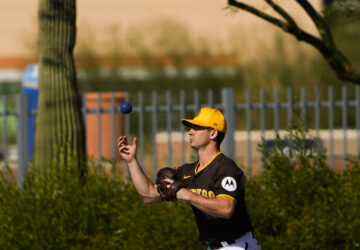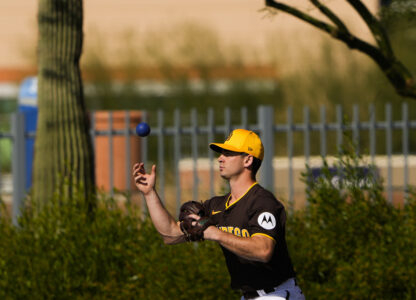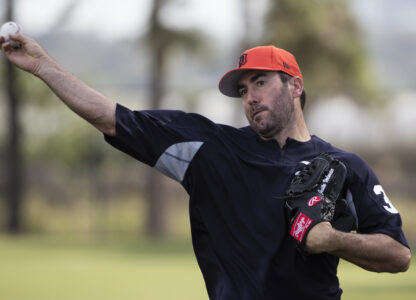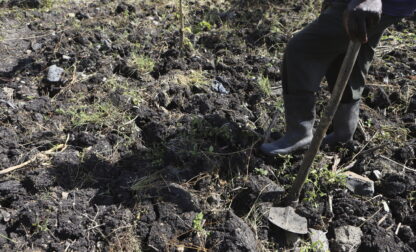SEATTLE (AP) — Justin Verlander was a gangly teenager. His parents jokingly called him a “brontosaurus.”
Long before he became a three-time Cy Young Award winner, he was a high schooler who couldn’t consistently muster the arm strength needed to get drafted. So he went to college, took the time he required to mature as a pitcher via traditional training methods, and eventually developed an arm that pushed him from prospect into major leaguer and ultimately an ace.
With today’s sophisticated training methods creating opportunities — and pressure — for young pitchers to reach exceptional velocities as early as possible, Verlander may never have gotten that time to evolve into one of the top pitchers in his generation.
“I am not envious of parents of young pitchers in baseball right now,” he said. “If I had a kid in baseball, it’d be a very, very difficult decision to make. Where do I find the right help? How do I get them to the right place? How do I let them grow? Like, he’s obviously got talent.
“These are questions I would ask myself, and I don’t have the answers, and here I am at the highest level. I mean, my family didn’t have a baseball background at all, like, what the hell would they do? No idea.”
The velocity age
Velocity training is the rage in baseball from the youth levels up through the majors. Players go through specialized programs — often using series of progressively weighted baseballs — in the hopes of speeding up their bodies and arms, pushing them to the limits of what might be possible for their age and ability.
Videos of teenagers trying to hit max velo inside training facilities populate social media. They get likes. They draw attention. Their arms can do incredible things. But frequently, their ligaments cannot. Dr. Gary Waslewski, who works with the Arizona Diamondbacks, told the AP in March that “velocity kills elbows.”
Want proof? Look at the situation in the majors this year, which Verlander called a “pandemic” in April. The names of major leaguers shut down in the last 12 months by arm problems could fill out an All-Star roster: Spencer Strider, Cristian Javier, Shane Bieber, Eury Pérez, Shane McClanahan, Félix Bautista and Matt Brash are just some of the names of top pitchers who have undergone major elbow procedures. Forget about staying durable and winning 300 games. Even 200-game winners may soon be extinct.
The concern at the major league level is real. The bigger worry could be what’s taking place with younger ages, where teenagers are undergoing the same surgeries as major leaguers at an alarming rate. There’s no hard data, only anecdotal stories. But they’re getting louder and more common.
It’s the byproduct of the quest for more velocity, more spin, more of the pitching attributes that scouts and recruiters are seeking at a younger age where life-altering money – either through NIL deals in college or a pro baseball contract — is at stake.
Get on the radar of scouts as a high school or college pitcher — throw hard.
Move up through the minors — throw hard.
Find a role on a major league pitching staff — throw hard.
“Now when you go into high school ballparks, it’s amazing how many kids are throwing 97, 98 (mph),” Seattle Mariners senior director of amateur scouting Scott Hunter said.
The idea of developing arm strength slowly and seeing those increases in pitch speed simply by playing long-toss and throwing bullpens is now antiquated in the context of today’s advances in information and training.
How much that velocity training is playing a role in what’s happening with injuries is one of the great unknowns in baseball right now. Verlander imagines the uncertainty is maddening for families.
“All of a sudden as a parent your kid goes and optimizes themselves and blows out, you feel like, ‘well, I (messed) that up.’ Did you? You make the best decision you possibly could. I don’t know man. This is what I mean, it’s just a bad cycle and if we don’t rewind it quickly it’s going to be even worse than it is now by tenfold,” Verlander said.
Throw first, worry later
Elite pitchers with professional aspirations have mostly embraced velocity training as the best path to fulfill their dreams. Many are undeterred by injury concerns.
The AP surveyed 25 top major league draft pitching prospects during the combine in June in Phoenix about their use of advanced training methods.
Seventeen of the 25 said they had done some type of weighted-ball training in the hopes of increasing their velocity. Three said they had started the training at 12 years old, while more than half said they started between the ages of 16 and 18.
Perhaps most notable in the survey was the overall lack of anxiety about arm injuries. Asked to rate their concern on a 1-10 scale, no one rated their worry higher than a five, with 14 rating it a zero or a one. With rising success rates on Tommy John surgery and other advances allowing players to continue their careers even after several major injuries, the incentives are clear, even for pitchers aware of the risks: throw hard first, and worry about potential injuries later.
“I didn’t throw hard when I was younger,” said LSU lefty Justin Loer, who rated his concern a four. “That’s where that (elbow injuries) comes from, so I’m a little worried now that I’m throwing harder.”
Developed in a lab
Driveline Baseball sits in a non-descript office park about 20 miles south of downtown Seattle that from the outside masks the baseball laboratory major leaguers have flocked to for training.
Need a boost on your velo? Go to Driveline. Need more spin? Go to Driveline. Reshape your slider? Go to Driveline.
It’s made Driveline a singular name known throughout baseball without need for explanation. They were one of the first training facilities to throw together biomechanics, weighted ball training and technology into a mixing bowl and emerge with an improved pitcher, often with increased velocity or increased spin rate. While Verlander developed by facing hitters and adjusting as he went, today’s pitchers can train in a lab, emerge with incredible stuff and figure out how to make it work in games when they get there.
The success of Driveline’s programs have sparked growth to the industry. Whether it’s Florida, Texas, North Carolina, Georgia, Arizona, California or Wisconsin, players can find facilities where the goal of throwing faster is the selling point.
“The pure velo gains, the pure stuff all over the country is getting so loud,” Hunter said. “I don’t know if it’s the pitching labs in college or just the way people are training these days with private facilities and kids getting bigger and stronger and learning how to throw hard at an earlier age.”
While Driveline and similar facilities have faced their share of criticism, they’ve also demystified what makes good players good. And for pitchers it’s goes back to velocity and spin rate, which comes from arm speed. Teams know it. Teams search for it. And that’s why Driveline and similar facilities are unlikely to stop pushing athletes to pursue those things.
“I do think that data inherently has an ability to bring equity to things because it provides an unbiased source of clarity about where you are and what you need,” said Deven Morgan, Driveline’s director of youth baseball. “And that is a big lever to throw, especially if you consider like the parents dilemma in 2024 where you have a kid that wants to be good, you want them to be good and you have no idea what the path is, and these ideas of bat speed and exit velocity, throwing velocity either feel threatening or mystical.”
‘Reverse the trickle down’
Of course, kids want to throw hard. It’s part of the fun, the aura of playing baseball. But the cost could be adding up even as videos of kids pitching in showcase events trying to max out their velocity flood social media.
Verlander reflected on his path. He started to show some flashes of talent around 10, but at that time the path toward success was traditional and straight forward for his family to navigate.
“I started showing some real talent. I was clearly better than most of the kids around me, or just had a natural ability,” Verlander said. “Nowadays, what do (my parents) do? They probably send me to one of those camps.”
Verlander knows the current direction of pitching isn’t going to change before his career ends. He believes if starting pitching is incentivized at the major league level — the idea of pitchers working through trouble and going through a batting order more than just twice — that there can be another trickle-down where pitching at max effort for max velocity becomes less emphasized.
“I’ve heard Rob Manfred say out of his mouth, we need to bring the starting pitcher back. How you put that genie back in the bottle is a tougher question,” Verlander said. “I think we need to put a lot of heads together and come up with a way. And it’s probably not going to be perfect at first, but you reverse the trickle down.”
___
AP Baseball Writer David Brandt and AP Sports Writer John Marshall contributed.
___
AP MLB: https://apnews.com/hub/mlb



















